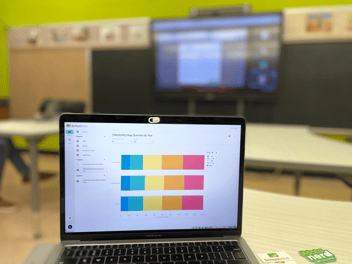
A well-implemented Multi-Tiered System of Supports (MTSS) framework is a key tool for schools and districts to support students. When enhanced by robust student data, MTSS becomes an incredibly powerful tool for identifying students who need help, documenting intervention efforts, tracking progress, and evaluating outcomes. This data-driven approach ensures that schools can meet the diverse academic, behavioral, social, and emotional needs of their students with greater precision.
After working with our district partners to build extensive MTSS workflows that are creating a new idea of what's possible for data-enriched student support, we have observed four critical phases of an exceptional end-to-end "enhanced MTSS with student data" system: Identification, Documentation, Tracking, and Evaluation.

Phase 1: Identification — The Power of Multidimensional Data
The first step in any MTSS process is identifying which students need additional support. Traditionally, this process relied heavily on teacher observations or a single, often outdated, data point, such as last year's test scores. However, an enhanced MTSS framework leverages a multidimensional view of data, all housed in one central platform like Schoolytics, making it easier to pinpoint students at risk across one or multiple domains—behavior, attendance, academics, and mental health.
In an effective MTSS system, data from various sources should be interconnected, offering educators a holistic view of the student’s performance and well-being. This multidimensional approach helps to avoid the narrow focus on one issue while missing underlying or contributing factors.
Key Data Points for Identification
-
Academics: Identifying students who are performing below grade level is one of the primary efforts in MTSS. There are many sources of academic data that are useful for this task: formative and summative assessment scores, grades, homework completion, etc. This can be quite difficult in many student information systems to get just the right list. For example, students who are falling behind in credits needed for graduation are obvious groups to track, but the logic required for such a project is not easily set up. Moreover, for secondary students, it is not obvious to one teacher that a student is struggling in more than one subject.
-
Attendance: Flagging students who are chronically absent or are approaching chronic absenteeism, whether through unexcused or excused absences, is a critical need for most districts right now. Research shows that chronic absenteeism is a significant indicator of future academic challenges, making it a key component of early identification in MTSS. But again, attendance data is one of the most difficult data challenges to get right, with so many nuances to what counts as present or absent. Many districts can only track negative attendance events, and are not able to get attendance rates very easily from their current data infrastructure.
-
Behavior: Minor behavior incidents as well as major ones are part of a comprehensive MTSS implementation for any school site. Behavioral incidents offer important clues, especially for students who may otherwise perform well academically but are facing challenges in other areas of their lives. Districts regularly need to initiate behavior interventions for students who are struggling with following rules and social norms; however, many current software systems used by schools lack the ability to track minor behavior issues.
-
Mental Health: Data from surveys, counselor reports, or other assessments can shed light on students who are experiencing mental health challenges. By integrating mental health data into the MTSS identification process, schools can ensure that these students receive the support they need. Connecting this data with other indicators is often challenging without a comprehensive platform like Schoolytics.
Educators often need to generate lists of students who meet predefined criteria based on the convergence of these data points to proactively address student needs before they escalate into larger issues. Schoolytics simplifies the identification phase by bringing together multiple dimensions of student data into one centralized platform. Educators can easily view data on academics, attendance, behavior, and even mental health, allowing them to identify students who need additional support. With Schoolytics, setting customized criteria for identifying at-risk students is streamlined—like if you're looking for students who have missed more than 10% of school days, are failing multiple classes, AND are frequently tardy. One recent request from a school district involved generating a list of 10th grade English Language Learners at three of their six high schools who got a D or F in "Basic Math" in 9th grade. Schoolytics provides instant access to these type of lists, making the early intervention process faster and more data-driven. This empowers schools to act before issues escalate, ensuring that no student falls through the cracks.
Phase 2: Documentation — Creating a Cohesive Record of Support
Once students have been identified, the next step in an data-driven MTSS process is documenting their support journey. Proper documentation is crucial to ensuring that all staff members involved in the student’s learning journey are on the same page, have access to relevant information, and can track the student's progress over time. It also creates a permanent record of the interventions, strategies, and goals established for each student. This is incredibly helpful for compliance.
In an enhanced MTSS system, documentation should be both comprehensive and user-friendly. Schools need to track a wide array of data points: from the initial referral, through intervention plans, to ongoing progress monitoring, meetings, notes, and tasks. It’s vital to have all documentation digitized and centralized in a single platform—whether that’s Schoolytics, a Student Information System (SIS), or another system of record.
The documentation actions we're referring to are:
- Logging events such as meetings, behavior incidents, and progress towards goals.
- Creating intervention plans, referrals and forms tailored to the student's needs, documenting the type, frequency, and expected outcomes of each intervention.
- Tracking progress through regular updates, meetings, and milestones, ensuring everyone involved is aligned and aware of the student's journey.
- Setting goals with measurable outcomes, making it easier to assess whether interventions are effective.
Comprehensive documentation not only helps individual students but also streamlines the workflow for staff by providing a consistent process and clear communication channels.
Schoolytics excels in the documentation phase by offering intuitive, customized tools for creating and managing MTSS-related records. Educators can create detailed intervention plans, referral records, meeting notes, tasks, and progress toward goals. Whether a teacher needs to log an intervention or an administrator wants to review past meetings, all relevant documentation is centralized and easily accessible. The platform helps eliminate paperwork clutter, streamlines communication, and provides a seamless record-keeping system, so that the MTSS process remains organized and transparent.
Phase 3: Tracking — Gaining Insights from Data
Tracking the progress of students within the MTSS framework is crucial for ensuring that interventions are effective and students are improving. An enhanced MTSS system allows schools to access real-time data on the status of students, interventions, and outcomes.
By aggregating and analyzing MTSS data, schools can:
-
Monitor interventions: To put it simply, this is simple "counting beans", but it's still important to know things like how many interventions have been implemented, and how many students are currently receiving Tier 2 or Tier 3 supports.
-
Assess disproportionality: Track whether certain subgroups of students—such as English learners, students of color, or students with disabilities—are disproportionately represented in specific MTSS tiers. This helps schools address potential equity issues.
-
Evaluate the timeliness of interventions: Some interventions may take longer than expected to yield results. A tracking system can flag which students have been in interventions for extended periods, prompting a review to determine if adjustments are needed.
-
Track referral patterns: Understanding the volume and type of referrals helps schools anticipate trends and allocate resources more effectively.
The ability to see both the macro trends (such as how the number of students in each tier changes over time) and micro-level data (such as individual student progress) gives educators the insight needed to adjust strategies as necessary. Tracking student progress within the MTSS framework is simplified with Schoolytics' robust reporting features. School staff can generate reports on the number of students in various MTSS tiers, the number of active interventions, and track how these figures change over time. Schoolytics also provides visibility into trends such as the duration of interventions or whether certain subgroups are overrepresented in higher tiers, which helps schools identify potential disproportionality. With its clear dashboards and customizable reporting tools, Schoolytics makes it easy to keep tabs on the success of interventions and adjust strategies in real time, ensuring that schools remain responsive to student needs.
Phase 4: Evaluation — Connecting the Dots Between Interventions and Outcomes
The final phase of the enhanced MTSS process is evaluating the effectiveness of interventions. While tracking shows you what’s happening, evaluation helps you understand why it’s happening and whether interventions are truly driving positive outcomes.
In an enhanced MTSS system, evaluation is about connecting the dots between interventions and results. For example:
-
Academic interventions: Does providing a student with extra tutoring or a modified learning plan lead to improved scores on formative assessments or higher grades?
-
Attendance interventions: If a school implements an attendance improvement plan, such as sending positive notes home for improved attendance, does it lead to fewer absences over time?
-
Behavior interventions: How do behavior-specific supports, such as restorative justice practices or counseling, impact both short- and long-term behavioral outcomes?
Schools and districts should be analyzing the impact of specific interventions at both the individual student level and the program level, ensuring that every aspect of the MTSS process is optimized for effectiveness. For instance, if a district implements an independent study program to combat chronic absenteeism, the data collected through an enhanced MTSS system can show whether this policy change leads to a measurable reduction in absenteeism rates. This type of macro-level evaluation enables schools to refine broader policies and initiatives based on data-driven insights.
In the evaluation phase, Schoolytics stands out by having the outcomes data already in place, so connecting interventions to real-world outcomes allows districts to assess what works and why. Identifying the impact of specific interventions on key outcomes, such as linking academic supports to improvements in test scores or grades, or correlating attendance interventions with a decrease in absences, is fairly straightforward. Schoolytics' data visualization tools make it easy to "connect the dots" between interventions and results, thereby ensuring that schools can fine-tune their approaches and maximize student success.
Conclusion
A data-enriched MTSS system transforms how schools identify, document, track, and evaluate student support efforts. By using Schoolytics, educators can harness the power of data to ensure every student receives the support they need to thrive. With this end-to-end approach, districts can be proactive, data-driven, and, most importantly, student-centered.
Related Articles


How to Pay for MTSS & Analytics Software: Harnessing Federal Funds
School districts are facing budgetary constraints that make it difficult to pay for new, innovative...
.png?width=352&name=sel%20survey%20(1).png)
Schoolytics: Analyzing Student Survey Data
Surveys like the Panorama Student Survey provide invaluable insights into the social-emotional...

